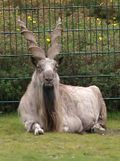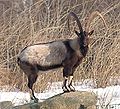
of mammals, the goats or wild goats, composed of up to nine species
including the wild goat
, the markhor
and several species known as ibex.
The domestic goat (Capra aegagrus hircus) is a domesticated subspecies
of the wild goat
(Capra aegagrus).
Wild goats are animals of mountain habitats. They are very agile and hardy, able to climb on bare rock and survive on sparse vegetation. They can be distinguished from the genus Ovis
, which includes sheep, by the presence of scent glands close to the feet, in the groin and in front of the eyes, and the absence of other facial glands, and by the presence of a beard in the males, and of hairless callus
es on the knees of the forelegs.
The Rocky Mountain goat
is in a separate genus, Oreamnos
, and is not dealt with here.
Taxonomy
All members of the Capra genus are bovids (members of the family Bovidae) and caprids (subfamily Caprinae). All these are ruminant
s, meaning they chew the cud, and have a four-chambered stomach which plays a vital role in digesting, regurgitating and re-digesting their food.
The genus has sometimes been taken to include Ovis
(sheep) and Ammotragus (Barbary Sheep
), but these are usually regarded as distinct genera, leaving Capra for goats and ibexes. In this smaller genus, some authors have recognized only two species, the Markhor
on one side and all other forms included in one species on the other side. Today nine species are usually accepted:
- Spanish ibexSpanish ibexThe Iberian ibex, Spanish ibex, Spanish wild goat, or Iberian wild goat is a species of ibex with four subspecies. Of these, two can still be found on the Iberian Peninsula, but the remaining two are now extinct. The Portuguese subspecies became extinct in 1892 and the Pyrenean subspecies became...
(Capra pyrenaica) - Alpine ibexAlpine IbexThe Alpine ibex, , is a species of wild goat that lives in the mountains of the European Alps. In its habitat region, the species is known as bouquetin , steinbock , and stambecco ....
(Capra ibex) - Nubian ibexNubian IbexThe Nubian ibex is a desert-dwelling goat species found in mountainous areas of Israel, Jordan, Saudi Arabia, Oman, Egypt, Ethiopia, Yemen, Sudan, and Pakistan. It is generally considered to be a subspecies of Alpine ibex, but is sometimes considered specifically distinct...
(Capra nubiana) - Siberian ibexSiberian IbexThe Siberian Ibex or Common ibex is a species of ibex that lives in central and northern Asia. It has traditionally been treated as a subspecies of the Alpine Ibex, and whether it is specifically distinct from other ibex is still not entirely clear...
(Capra sibirica) - Walia ibexWalia IbexThe walia ibex is a species of ibex that is endangered. It is sometimes considered a subspecies of the Alpine Ibex...
(Capra walie) - West Caucasian turWest Caucasian TurThe West Caucasian tur is a mountain dwelling goat antelope found only in the western half of the Caucasus Mountain range....
(Capra caucasica) - East Caucasian turEast Caucasian TurThe East Caucasian tur is a mountain dwelling goat antelope found only in the eastern half of the Caucasus Mountains....
(Capra cylindricornis) - Wild goatWild GoatThe wild goat is a widespread species of goat, with a distribution ranging from Europe and Asia Minor to central Asia and the Middle East. It is the ancestor of the domestic goat.-Social structure:...
(Capra aegagrus)- Domestic goat (Capra aegagrus hircus, sometimes referred to as Capra hircus; includes feral goatFeral goatThe feral goat is the domestic goat when it has become established in the wild. Feral goats occur in Australia, New Zealand, Ireland, Great Britain, Hawaii, the Galapagos and in many other parts of the world...
)
- Domestic goat (Capra aegagrus hircus, sometimes referred to as Capra hircus; includes feral goat
- MarkhorMarkhorThe Markhor is a large species of wild goat that is found in northeastern Afghanistan, Pakistan , India, southern Tajikistan and southern Uzbekistan...
(Capra falconeri)
The goats of the genus Capra have complex systematic relationships, which are still not completely resolved. Recent studies based on mitochondrial DNA
suggest that the Siberian ibex and the Nubian ibex represent distinct species, which are not very closely related to the physically similar Alpine ibex. The Alpine ibex forms a group with the Spanish ibex. The West Caucasian tur appears to be more closely related to the wild goat than to the East Caucasian tur. The markhor
is relatively little separated from other forms — previously it had been considered to be a separate branch of the genus.
Almost all wild goat species are allopatric (geographically separated) — the only geographical overlaps are the wild goat (Capra aegagrus) with the East Caucasian tur (Capra cylindricornis), and the markhor (Capra falconeri) with the Siberian ibex (Capra siberica). In both cases the overlapping species do not usually interbreed in the wild — however, in captivity all Capra species can interbreed, producing fertile offspring.
Species and subspecies of goats
 |
Capra caucasica | West Caucasian tur West Caucasian Tur The West Caucasian tur is a mountain dwelling goat antelope found only in the western half of the Caucasus Mountain range.... |
 |
Capra cylindricornis | East Caucasian tur East Caucasian Tur The East Caucasian tur is a mountain dwelling goat antelope found only in the eastern half of the Caucasus Mountains.... |
 |
Capra falconeri | Markhor Markhor The Markhor is a large species of wild goat that is found in northeastern Afghanistan, Pakistan , India, southern Tajikistan and southern Uzbekistan... |
 |
Capra aegagrus | Wild goat Wild Goat The wild goat is a widespread species of goat, with a distribution ranging from Europe and Asia Minor to central Asia and the Middle East. It is the ancestor of the domestic goat.-Social structure:... |
 |
Capra (aegagrus) hircus | Domestic goat |
 |
Capra sibirica | Siberian ibex Siberian Ibex The Siberian Ibex or Common ibex is a species of ibex that lives in central and northern Asia. It has traditionally been treated as a subspecies of the Alpine Ibex, and whether it is specifically distinct from other ibex is still not entirely clear... |
 |
Capra pyrenaica | Spanish ibex Spanish ibex The Iberian ibex, Spanish ibex, Spanish wild goat, or Iberian wild goat is a species of ibex with four subspecies. Of these, two can still be found on the Iberian Peninsula, but the remaining two are now extinct. The Portuguese subspecies became extinct in 1892 and the Pyrenean subspecies became... |
| Capra walie | Walia ibex Walia Ibex The walia ibex is a species of ibex that is endangered. It is sometimes considered a subspecies of the Alpine Ibex... |
|
 |
Capra ibex | Alpine ibex Alpine Ibex The Alpine ibex, , is a species of wild goat that lives in the mountains of the European Alps. In its habitat region, the species is known as bouquetin , steinbock , and stambecco .... |
 |
Capra nubiana | Nubian ibex Nubian Ibex The Nubian ibex is a desert-dwelling goat species found in mountainous areas of Israel, Jordan, Saudi Arabia, Oman, Egypt, Ethiopia, Yemen, Sudan, and Pakistan. It is generally considered to be a subspecies of Alpine ibex, but is sometimes considered specifically distinct... |
Domestication and uses

. Easy human access to goat hair, meat
, and milk
were the primary motivations. Goat skins were popularly used until the Middle Ages
for water and wine bottles when traveling and camping
, and in certain regions as parchment
for writing.
In ancient history
Evidence of the ibex is widely present in the archaeological record, particularly in the Near Eastand Mediterranean regions. Ibex motifs are very common on cylinder seal
s and pottery, both painted and embossed.
Excavations from Minoan
Crete
at Knossos
, for example, have yielded specimens from about 1800 BC, including one cylinder seal
depicting an ibex defending itself from a hunting dog
. From the similar age a gold jewelry ibex image was found at the Akrotiri archaeological site on Santorini
in present day Greece.
An Iron Age
Capra ibex specimen was recovered at the Aq Kupruk
Archaeological site in present day Afghanistan
, illustrating either domestication or hunting of the ibex by these early peoples. However, archaeological records of ibex can be difficult to separate from those of domestic goats.
Associations in history
It has been proven, after much historical dispute, that rock carvings and the horns of ibex were once used as a charm to encourage childbearing or to give thanks for a child by those that were involved in the Buddhism religion around the periods of 1000 B.C. to 300 A.D. As commented on by historian and archaeologist, A. H. Francke:"Our Christian evangelist at Khalatse
KhalatseKhaltse or Khalsi is a village 337 km from Srinigar on the old main road to Leh, where it crossed the Indus over an iron bridge. The population for the region is about 1,600. Much of its importance is because it is the place where the road from Kashmir debouches into the Indus Valley...
had become a father a few weeks before, and the people of the village had made presents of "flour-ibex" to him and his wife. He gave me one of those figures, which are made of flour and butter, and told me that it was a custom in Tibet and Ladakh, to make presents of "flour-ibex" on the occasion of the birth of a child. This is quite interesting information. I had often wondered why there were so many rock carvings of ibex at places connected with the pre-Buddhist religion of Ladakh. Now it appears probable that they are thank offerings after the birth of children. As I have tried to show in my previous article, people used to go to the pre-Buddhist places of worship, in particular, to pray to be blessed with children."

